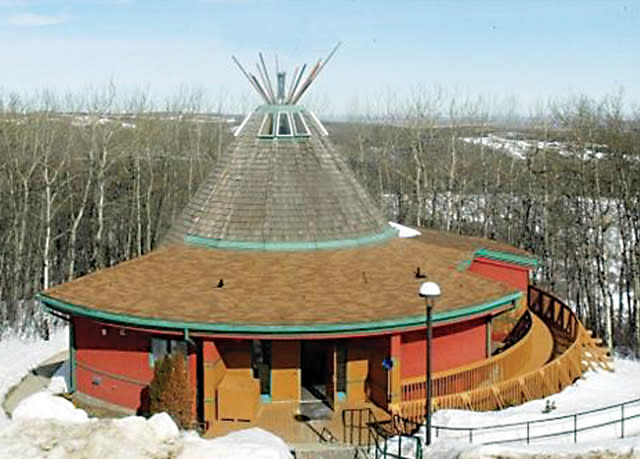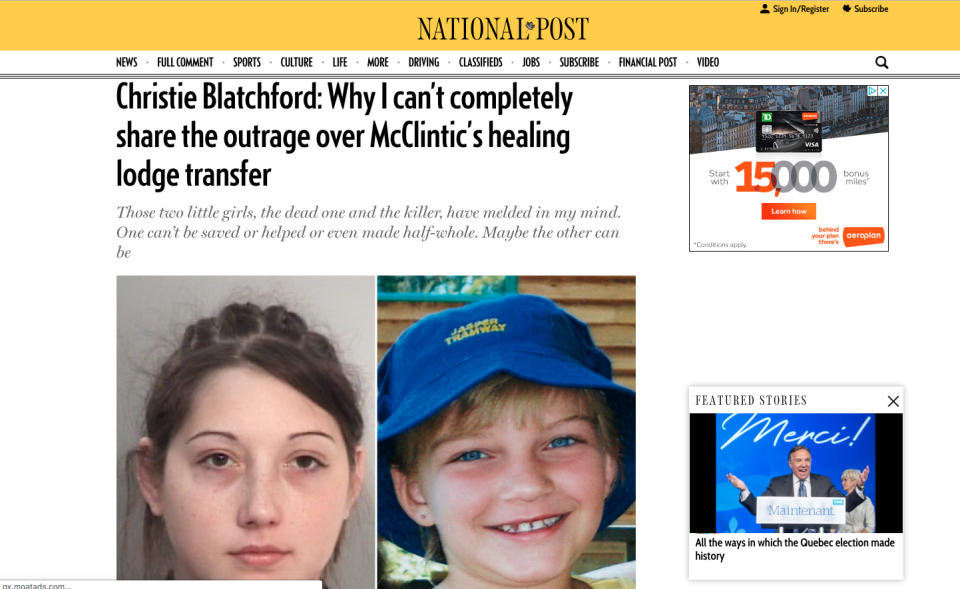What Tori Stafford's father has to say to his daughter's murderer

Rodney Stafford says he doesn’t want vengeance against his daughter’s killer. He just wants to feel like the system intended to deliver justice to offenders like Terri-Lynne McClintic isn’t failing their victims.
“If this is something that can happen to an eight-year-old child and there’s no justice for it, then that’s a big issue,” Stafford said in an interview with Yahoo Canada News.
McClintic was convicted in 2010 of first-degree murder and sentenced to life in prison for her role in the kidnapping, rape and murder of eight-year-old Victoria ‘Tori’ Stafford in Woodstock, Ont. in April 2009.
Just eight years into McClintic’s 25-year minimum sentence, Correctional Service Canada transferred her from Grand Valley Institution for Women, a women’s prison in Kitchener, to a healing lodge in Saskatchewan.

Okimaw Ohci Healing Lodge for Aboriginal Women aims to rehabilitate incarcerated women using traditional Indigenous teachings, ceremonies and workshops.
Located 150 kilometres from the nearest large city, Medicine Hat, Alta., Okimaw Ohci is a minimum-medium security facility. Offenders live in single and family residential units. Some live there with their children. Each unit includes a bedroom, a bathroom, a kitchenette with an eating area and a living room. There are 60 beds, and Terri-Lynne McClintic occupies one of them.
Stafford found out about the move in September this year, nine months after it took place. He said it was mentioned as an afterthought in a discussion with Correctional Service Canada about a parole board request by McClintic for additional day leaves.
“…Those two little girls, the dead one and the killer, have melded in my mind somehow. One can’t be saved or helped or even made half-whole. Maybe the other can be.” – Christie Blatchford, National Post
“I would like for her to go back to her cell where she belongs. Victoria spent the last three hours of her life scared out of her tree,” he said. “Ultimately, she was tortured and raped and murdered. Where do Terri-Lynne’s rights…override the victim’s?”
The news left him feeling angry, re-victimized and failed by Canada’s justice system. So he quickly set to work to gain public support for a reversal of the transfer.
“I would have been totally fine if Terri-Lynne had gone in, done her time, did the programs she needed to rehabilitate her life the way you’re supposed to in an institution,” he said. “And if we had been able to have our say and just be a part of things.”
When the transfer was reported by the London Free Press on Sept. 25, it sparked outrage across the country.
Can you rehabilitate a murderer?

Amid cries to return the convicted child murderer back to a traditional detention centre, National Post writer Christie Blatchford advocated for tolerating the transfer in a divisive column.
Citing McClintic’s own ghastly childhood — raised by an alcohol-addicted exotic dancer and ferried from one institution to another — Blatchford argued that McClintic was a “damaged creature” whose entire childhood experience was “…to be hurt and ruined.”
“I understand the public outrage. I just can’t share it completely,” Blatchford wrote. “Those two little girls, the dead one and the killer, have melded in my mind somehow. One can’t be saved or helped or even made half-whole. Maybe the other can be.”
Online reactions to the piece were mixed, but appeared to skew toward negative.


@blatchkiki I read your article and saw the video of the confession. The only reason why Mcclintic cried was because she didn't like seeing the assault and murder NOT BECAUSE SHE FELT EMPATHY FOR TORI!!! She needs to be behind bars. Real bars, not pretend bars.
— Donald🇨🇦🇨🇦🇨🇦🇨🇦🇨🇦 (@Donald80683935) October 2, 2018
Finally a @blatchkiki column that makes sense.
— … – – – … (@Garence_) October 2, 2018
Cécile Rousseau, a clinical psychologist who works at the Montreal Children’s Hospital, echoed some of Blatchford’s sentiments.
“Being able to heal and to recover is ultimately always a better solution for society,” she said.
“But on the other hand, society has the right to decide about punishments and consequences and that is not for us clinicians to decide, it’s for social consensus.”
‘She’s entitled to her opinion’
While it may seem an impossible feat for a father who has lost a child, Stafford said he does not entirely disagree with Blatchford’s column.
“She’s entitled to her opinion and she does make some very good points in the article,” he said.
“I agree with her that yes, there is the possibility for [McClintic] to work on her trauma…but those are all things she should be working on inside the facility, and not assaulting other inmates.”
Stafford was referencing an incident in 2012 in which McClintic admitted to beating up a fellow inmate at Grand Valley Institution for Women and said she regretted not injuring the woman more.
He also doesn’t outright disagree with the notion that some offenders’ trauma and experiences should be weighed against their crimes. He said he believes Indigenous healing lodges have a place in Corrections, just not for someone convicted of kidnapping and murdering a child who hasn’t completed even a fraction of a life sentence.
“…It should not even be an option until she’s eligible for parole if that be the case,” he said. “Be that model inmate through the course of your sentence, to prove that you warrant [being in a healing lodge] to slowly work you way back onto the streets.”
According to Chief Alvin Francis of Nekaneet First Nation, in whose community Okimaw Ohci Healing Lodge is situated, if the decision were up to Nekaneet elders, the transfer may never have taken place.
“We were surprised to learn from the public that Ms. McClintic was transferred to the Okimaw Ohci Healing Lodge,” Francis said in the release.
In the past, Francis said, Nekaneet elders were involved in the admission process and had some influence over who was admitted to the healing lodge. But today, admission to the lodge is entirely up to the discretion of Correctional Service Canada.
“We have no say on inmate selection, but I believe if our elders were still a part of the process, maybe Ms. McClintic wouldn’t be at the healing lodge.”
Political reaction
On Sept. 28, Stafford appealed in an open letter to Prime Minister Justin Trudeau to have McClintic returned to the Grand Valley Institution for Women in Kitchener. By then, news of the transfer had reached the highest levels of government, where it became a new point of contention between the Liberals and the opposition Conservatives.
On Oct. 3, the federal Conservatives tabled a motion to reverse McClintic’s transfer and condemn the Correctional Service of Canada for approving it. The motion was defeated by a vote of 200 to 82, with New Democrats and Green Party Leader Elizabeth May siding with Liberals.
During question period that day, Trudeau accused the opposition of behaving like “ambulance chasing politicians.”
While the federal government does not have the power to reverse the decision, Public Safety Minister Ralph Goodale has instructed Correctional Service officials to review the transfer.
In the meantime, Stafford and a group of supporters are organizing a march on Parliament Hill on Nov. 2 in protest of the transfer.
With each call to action, he is reminded of Victoria and the agonizing final moments of her life. But the belief that he is doing the right thing propels Stafford forward.
“I will relive this every day if I have to,” he said. “If it means to get full and complete justice for Victoria.”

